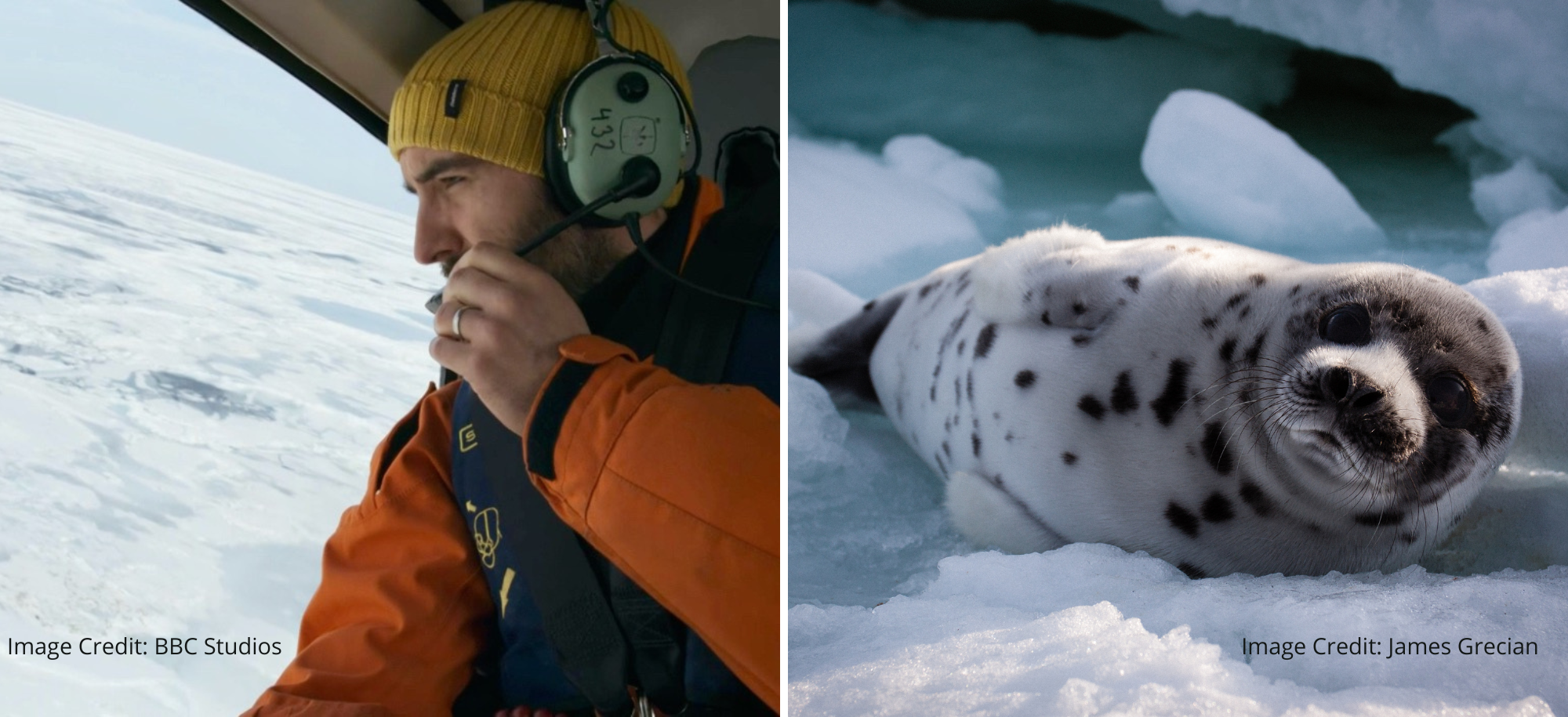Tracking harp seals in Canada

Dr James Grecian was part of the final episode of Frozen Planet II where he talks about the migration of harp seals.
It’s late March 2019 and I’m standing in the middle of the Gulf of St Lawrence, Canada. 18 inches of sea ice are all that separate me from 200m of freezing cold water. In front of me, three harp seal mothers are nursing their white-coated pups.
It’s a strange sensation standing on sea ice. It’s hard not to think about what would happen if the ice cracked beneath my feet but, given I’m stood next to a two-ton helicopter, the ice can probably hold my weight.
I’m not prepared for how dynamic the ice is. Don, our pilot, shouts that the GPS on the helicopter has us floating along at three knots. The ice pack creaks and groans as the floes rub against each other and rock with the movement of the waves.
We’re here to study the first migrations of juvenile harp seals. Canada supports the largest population of these animals, and each spring the ice here in the Gulf of St Lawrence becomes a nursery as over a hundred thousand mothers give birth.
The ice provides a safe and stable platform for the seal pups to spend the first weeks of their lives. The harp seal has one of the shortest weaning periods and after just 12 days, the mothers will leave their pups to fend for themselves on the ice.
It is crucial that the ice remains stable during this time, but the Gulf is changing. The water is warming and sea ice conditions are becoming less predictable. The ice is forming up later in the winter season, melting earlier in spring, and the area covered by ice is shrinking.
We’re here to fit 12 weaned harp seal pups with small satellite transmitters that will allow us to track their movements as they leave the ice, learn to dive, and begin their migrations following the summer sea ice retreat.These three pups are too young to tag, so we leave them alone and head off in search of other suitable ice floes to land on.
We only have a small window of time when the seals are the right age to tag and the next day a storm grounds the helicopter. Over the next few days, the wind and currents take this ice patch, the seal pups and their mothers out of the Gulf and over a hundred kilometres offshore. Far beyond the reach of our helicopter.
We are joined in Canada by a small crew filming our expedition for Frozen Planet 2. I grew up on a diet of David Attenborough nature documentaries. In part, the stories told in series like ‘Trials of Life’, ‘Life in the Freezer’ and ‘The Life of Birds’ are the reason I pursued a career in ecology, so it feels slightly surreal to be sat round a table with them talking through our plans once the storm clears. A proper ‘pinch yourself’ moment!
A few days later the weather clears and after a few hours searching we find a patch of seals suitable for tagging. Over the course of a few helicopter flights, we were able to carefully tag the number of seal pups we required. The tags, which are simply glued to the seal’s fur, don’t hurt them and will fall off as the fur is moulted.
It’s incredible to be involved in a landmark series like Frozen Planet II, something I wouldn’t have believed possible as a child. I feel privileged to be able to share our harp seal story with millions of viewers around the world. They are an iconic symbol of the Arctic ocean, intrinsically linked to the sea ice, and emblematic of the changes we are seeing in these incredible and fragile places.
Frozen Planet II - Our Frozen Planet airs this Sunday 16th October at 8pm on BBC One.
Read more:
- The results of the study into the movements of juvenile harp seals was published earlier this year in the journal Royal Society Open Science. Environmental drivers of population-level variation in the migratory and diving ontogeny of an Arctic top predator is available open access here.
- Dr James Grecian is a post-doctoral researcher in the Department of Geography at Durham University. His research focuses on understanding how marine ecosystems are responding to the processes that define the Anthropocene, with expertise in the ecology of large marine vertebrates such as seabirds and seals.


/prod01/prodbucket01/media/durham-university/departments-/geography/Matt_Couchmann-3872X1296.JPG)